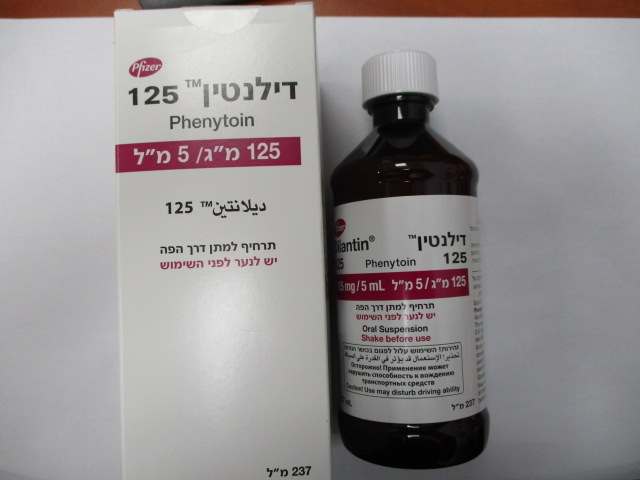Quest for the right Drug

דילנטין 125 DILANTIN 125 (PHENYTOIN)
תרופה במרשם
תרופה בסל
נרקוטיקה
ציטוטוקסיקה
צורת מתן:
פומי : PER OS
צורת מינון:
תרחיף : SUSPENSION
עלון לרופא
מינוניםPosology התוויות
Indications תופעות לוואי
Adverse reactions התוויות נגד
Contraindications אינטראקציות
Interactions מינון יתר
Overdose הריון/הנקה
Pregnancy & Lactation אוכלוסיות מיוחדות
Special populations תכונות פרמקולוגיות
Pharmacological properties מידע רוקחי
Pharmaceutical particulars אזהרת שימוש
Special Warning עלון לרופא
Physicians Leaflet
Posology : מינונים
2 DOSAGE AND ADMINISTRATION FOR ORAL ADMINISTRATION ONLY; NOT FOR PARENTERAL USE Serum concentrations should be monitored and care should be taken when switching a patient from the sodium salt to the free acid form. The free acid form of phenytoin is used in Dilantin-125/5ml Suspension. Because there is approximately an 8% increase in drug content with the free acid form over that of the sodium salt, dosage adjustments and serum level monitoring may be necessary when switching from a product formulated with the free acid to a product formulated with the sodium salt and vice versa. General: Dosage should be individualized to provide maximum benefit. In some cases serum blood level determinations may be necessary for optimal dosage adjustments—the clinically effective serum level is usually 10–20 mcg/mL although some mild cases of tonic-clonic (grand mal) epilepsy may be controlled with lower serum levels of phenytoin. With recommended dosage, a period of seven to ten days may be required to achieve steady-state blood levels with phenytoin and changes in dosage (increase or decrease) should not be carried out at intervals shorter than seven to ten days. Adult Dose: Patients who have received no previous treatment may be started on one teaspoonful (5 mL) of Dilantin-125/5ml Suspension three times daily, and the dose is then adjusted to suit individual requirements. An increase to five teaspoonfuls daily [625mg, (25ml)] may be made, if necessary. An oral loading dose of phenytoin may be used for non-emergency initiation of therapy in adults who require rapid steady state serum levels, and for whom intravenous administration is not desirable. This dosing regimen should be reserved for patients in a clinic or hospital setting where phenytoin serum levels can be closely monitored. Patients with a history of renal or liver disease should not receive the oral loading dose regimen. The recommended oral loading dose is one gram of phenytoin divided into three doses (400 mg, 300 mg, 300 mg) and administered at two hour intervals. Normal maintenance dosage is then instituted 24 hours after the loading dose, with frequent serum level determinations. Dosing in Special Populations Patients with Renal or Hepatic Disease: Due to an increased fraction of unbound phenytoin in patients with renal or hepatic disease, or in those with hypoalbuminemia, the interpretation of total phenytoin plasma concentrations should be made with caution. Unbound phenytoin concentrations may be more useful in these patient populations. Elderly Patients: Phenytoin clearance is decreased slightly in elderly patients and lower or less frequent dosing may be required. Pediatric: Initially, 5 mg/kg/day in two or three equally divided doses, with subsequent dosage individualized to a maximum of 300 mg daily. A recommended daily maintenance dosage is usually 4 to 8 mg/kg. Children over 6 years and adolescents may require the minimum adult dose (300 mg/day).

שימוש לפי פנקס קופ''ח כללית 1994
Grand mal & psychomotor seizures, trigeminal neuralgia
תאריך הכללה מקורי בסל
01/01/1995
הגבלות
תרופה שאושרה לשימוש כללי בקופ'ח
מידע נוסף
עלון מידע לרופא
31.05.22 - עלון לרופאעלון מידע לצרכן
04.01.16 - עלון לצרכן 24.02.16 - עלון לצרכן 16.08.20 - עלון לצרכן אנגלית 31.05.22 - עלון לצרכן אנגלית 31.05.22 - עלון לצרכן עברית 16.08.20 - עלון לצרכן ערבית 31.05.22 - עלון לצרכן ערבית 28.02.12 - החמרה לעלון 06.05.12 - החמרה לעלון 17.11.14 - החמרה לעלון 13.06.21 - החמרה לעלון 18.04.22 - החמרה לעלוןלתרופה במאגר משרד הבריאות
דילנטין 125